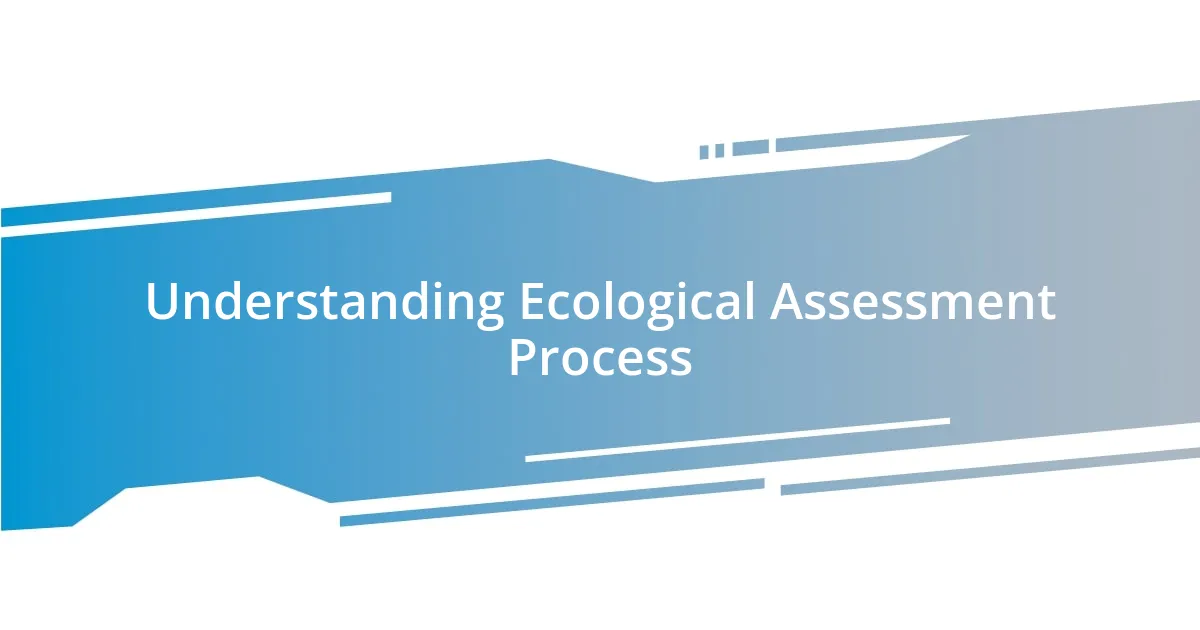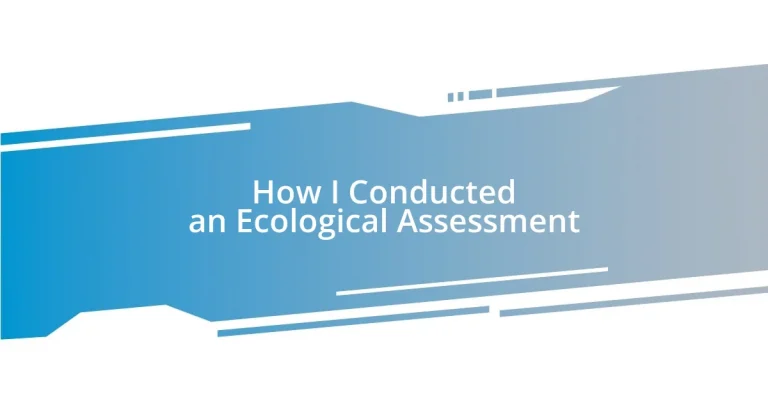Key takeaways:
- The ecological assessment process involves immersive fieldwork and a variety of data collection techniques to understand ecosystems beyond mere numbers.
- Preparation is key; defining goals, researching, and collaborating with experts enhances both accuracy and passion for the project.
- Selecting appropriate assessment methods (e.g., field surveys, remote sensing) tailored to specific ecosystems can significantly impact findings.
- Effective reporting and community engagement foster collaboration and inspire actionable recommendations for ecological management strategies.

Understanding Ecological Assessment Process
In my journey of conducting ecological assessments, I’ve learned that understanding the process is crucial. It’s not just about data collection; it’s about seeing the bigger picture, feeling the pulse of the ecosystem. Have you ever stood in a meadow, feeling the soft breeze and observing the diverse plant life? That’s the beauty behind the numbers.
The assessment typically begins with identifying the area of interest and gathering preliminary data. I vividly remember my first site visit; the smell of damp earth and the sound of rustling leaves instantly pulled me in. It’s during these initial moments that I realized how interconnected everything is—one small change can ripple through the entire ecosystem in ways we might not foresee.
Next comes fieldwork, a vital step that involves collecting samples, monitoring wildlife, and assessing habitat conditions. I find this hands-on approach incredibly rewarding. Have you ever held a soil sample in your hands, realizing it tells a story of its own? Each component provides invaluable insights into the health of the environment, making me appreciate the intricacies of nature even more.

Preparing for the Assessment Stage
Before diving into the assessment, I always take a moment to gather my thoughts and prepare mentally. This stage sets the tone for everything that follows. I recall one particularly ambitious project where I spent days preparing—reviewing ecological literature and making calls to local experts. The anticipation was electric, and it helped me feel grounded and focused.
To effectively prepare for the assessment, here are some essential steps to follow:
- Define the goals and objectives clearly to guide your assessment.
- Research existing data and gather relevant literature on the site.
- Assemble a team of specialists or volunteers who can contribute different expertise.
- Equip yourself with appropriate tools and technology for data collection.
- Schedule site visits and plan logistics—time of day can greatly impact your observations.
- Familiarize yourself with the site’s history and any previous assessments.
Embracing this preparatory stage not only enhances accuracy but fuels my passion for understanding the natural world. Each step feels like laying down a foundation, one that supports the intricate work of ecological assessment.

Selecting Appropriate Assessment Methods
Selecting the right assessment method can be a game changer in ecological assessments. From my experience, I’ve realized that different ecosystems require different approaches. For instance, while traditional field surveys provide a broader overview, remote sensing can yield striking visuals and data from hard-to-access areas. Have you ever tried aerial photography? It shifts your perspective entirely, revealing patterns invisible from the ground.
When considering various methods, it’s essential to weigh their suitability against the project’s specific goals. One time, I wrestled with a choice between using transects or quadrat sampling. Transects offered a continuous overview of the area, while quadrats provided more detailed species-level insights. In the end, I opted for quadrats, and I recall feeling exhilarated as I uncovered a rare plant species in a designated quadrant—a small victory that reminded me of the unique treasures nature holds.
It’s also important to consider the resources available for your assessment. In one of my past projects, limited funding led us to prioritize volunteer-led surveys rather than hiring professionals. It was a challenging decision, but I felt a sense of pride watching community members enthusiastically engage with the environment. Their insights and discoveries enriched our assessment and demonstrated the power of collective effort in ecological work.
| Method | Pros |
|---|---|
| Field Surveys | Comprehensive data collection; direct observation of species |
| Remote Sensing | Access to hard-to-reach areas; large-scale data gathering |
| Transect Sampling | Continuous overview of species distribution |
| Quadrat Sampling | Detailed species-level insights; great for studying specific areas |

Data Collection Techniques in Ecology
Data collection in ecology isn’t just about gathering numbers; it’s about capturing the essence of an ecosystem. Throughout my experiences, I’ve embraced various techniques like point count surveys for bird populations. I remember standing silently in a lush forest, pencil poised, heart racing as I noted the intricate melodies of unseen winged creatures. Each call was a reminder of the biodiversity surrounding me. Isn’t it exhilarating to connect with nature in such a direct way?
At times, I’ve relied on citizen science initiatives to enhance data collection. One instance stands out vividly: we partnered with local schools to monitor amphibian populations. I was astonished by the enthusiasm of the students, their eyes bright with curiosity. They became not just data collectors but advocates for local wildlife, sparking conversations about conservation in their own families. What could be more rewarding than watching young minds engage for a noble cause?
Additionally, modern technology has opened new avenues for data collection. I once integrated acoustic monitoring to record nocturnal sounds in a nearby wetland, and this innovation transformed my understanding of species activity patterns. The software provided a symphony of noises that helped me identify the presence of elusive species—each recording felt like unearthing a hidden treasure. Isn’t it fascinating how technology can deepen our ecological understanding? Through these varied techniques, I’ve learned that data collection is a blend of science and art, where every observation weaves together the larger narrative of our planet’s ecosystems.

Analyzing and Interpreting Data
Analyzing and interpreting data is like piecing together a captivating puzzle. During my first major ecological assessment, I remember staring at a sea of numbers from my field surveys. It was exhilarating yet daunting. With each calculation, I could almost hear the whispers of the ecosystem revealing its secrets, showing me which species thrived and which were struggling. Have you ever had that moment when a number suddenly makes everything click into place?
As I delved deeper into the data, patterns began to emerge that told a story. For instance, I discovered a correlation between water quality and the diversity of aquatic life in a local stream. I felt a rush of excitement—understanding these connections fueled my passion for conservation. What was particularly striking was how small fluctuations in nutrient levels could dramatically affect habitat health. This reinforced my belief that every detail matters.
In another project, I utilized software for statistical analysis that transformed raw numbers into visual representations. I vividly recall the thrill of seeing my data come to life in colorful graphs, illustrating changes over time. It wasn’t just about identifying trends; it was about communicating a message. I could suddenly visualize the impact of human activity on wildlife—each graph a reminder of the pressing need for informed action. Have you ever felt that surge of purpose when sharing crucial insights? That’s how data analysis can inspire change and foster a deeper understanding of our environmental responsibilities.

Reporting Findings and Recommendations
When it comes to reporting findings and recommendations, clarity is paramount. I recall one particular assessment where I had to present my findings to a diverse group of stakeholders. I structured my report with clear visuals and succinct bullet points. It was incredible to witness how accessible the information was for everyone, from seasoned ecologists to local community members. Have you ever noticed how a well-organized report can change the conversation and drive action?
In delivering recommendations, context matters deeply to me. For instance, I suggested practical measures to enhance habitat connectivity in a region experiencing fragmentation. Sharing specific, actionable steps not only increased buy-in but also illuminated pathways for collaboration. It’s empowering to inspire action—seeing stakeholders’ eyes light up with ideas inspires me to continuously refine how I communicate findings. After all, recommendations should be the spark that ignites further discussion and teamwork.
Moreover, I believe that follow-up and transparency are essential elements in this process. After one assessment, I initiated a series of workshops to discuss my findings and foster ongoing dialogue. It was rewarding to see how open communication led to innovative solutions, proving that the report was just the beginning rather than the end. Have you ever felt that sense of community grow when you engage others in the findings? It’s moments like these that remind me why sharing insights can lead to meaningful environmental change.

Implementing Ecological Management Strategies
Implementing effective ecological management strategies is about translating data into action. In a recent initiative focused on reforestation, I participated in a collaborative effort with local volunteers. I remember the thrill of planting the first sapling, feeling the earth between my fingers, as we worked together to restore a fragmented habitat. Have you ever felt the rush of hope when actively contributing to something much larger than yourself?
It’s in these hands-on experiences that I truly grasp the importance of adaptive management. After implementing the initial plantings, we monitored growth and gathered feedback from the volunteers. Sometimes, it was disheartening to see certain plant species struggling in the changing climate. This led us to adjust our approach, favoring native plants better suited to the environment. I believe adaptability is crucial—how can we expect to succeed without being willing to learn and evolve our strategies?
Moreover, engaging the community is a vital part of sustainable ecological management. I often reflect on a workshop I led where we explored local ecosystems. The enthusiasm in the room was palpable as community members shared their observations and concerns. Their insights helped shape our management decisions, reinforcing my belief that successful strategies come from collaboration. Have you ever seen how collective wisdom can enhance a project? It’s incredibly rewarding to see firsthand how a shared commitment can amplify our impact on the environment.












